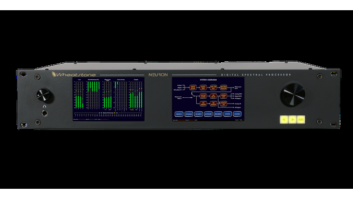Increasingly important in the audio chain is the ability to deliver audio using an IP network. The same IP network that lets you order products from Amazon or check your e-mail quickly is becoming a necessary method for receiving and delivering programming.
With networking technology as fast and cheap as it is, new ways of handling signals are as inevitable as ripples on a rainy pond.
Howard Mullinack, director of marketing for Wheatstone Corp., said low-cost Gigabit Ethernet drives studio product design.
“Gigabit Ethernet allows an ‘audio anywhere whenever you need it’ system without the need for the system administrator to set up Quality-of-Service or priority levels,” Mullinack said. “The affordability of Gigabit Ethernet switching allowed Wheatstone to develop the E-Square system, which was introduced at NAB2008.”
Wheatstone isn’t ready to turn all audio tasks over to IP networks, however.
“Audio-over-IP is simply another technology to move audio within a plant; it has its strengths and weaknesses compared with traditional TDM-based routing and mixing,” Mullinack said.

Marcus Xenakis, director of engineering and IT for Clear Channel Radio in Philadelphia, broadcasts live over IP from the annual Unity Day celebrations. Analog audio ruled the radio roost for nearly 80 years but the advantages of digital origination and distribution have taken hold in the past decade. Harris has been in the radio industry for much of the past century and has seen the changes. The company’s first audio-over-IP product was the IntraLink-IP in 2002.
“IntraLink-IP was a great product for its time, but as IP use grew we realized that people were ready for something new, designed from the ground up to take better advantage of the medium,” said Bob Band, global business development for Harris Intraplex Products.
Its Intraplex NetXpress IP Multiplexer is a modular system that can support up to 32 simultaneous streams, each of which may comprise multiple programs, in unicast or multicast format. Besides audio, it can carry many types of legacy data traffic and it also supports both T1 and E1 circuits, and can be used to bridge between different types of networks.
Axia continues to develop enhancements to its popular IP-Audio line of networked studio products. As the company’s adds more capabilities to IP-Audio, the developers’ eyes are focused on maintaining standards and ensuring compatibility with IP-Audio products and the larger IP universe.
“The core Axia technology is standards-based, so the very first Axia products are 100-percent compatible with our newest offerings and with off-the-shelf Ethernet switches from various manufacturers,” said Clark Novak, marketing director for Axia.
Novak cautions that there are different flavors of audio-over-IP and not all are equally tasty.
“Other products’ only way of interfacing with audio devices is to use analog or AES ports,” Novak said. “Sure, some products still need to connect through analog or AES and of course Axia does this, but [products increasingly] can connect directly to Livewire networks, which turns them into something more than just standalone audio sources — they become integrated resources for the entire networked facility.”
Broader IP universe
As soon as you venture outside of a predictable in-house network into the broader IP universe, network latency and packetization throw audio reliability into question. Products used to stream high-quality audio over the Internet must accommodate this network uncertainty.
“Moving from POTS and ISDN to IP required switching development paradigms,” said Darren Levy, international marketing manager for Tieline Technology. “We had to go from simple codecs working over smart networks to smart codecs working over dumb networks that didn’t care if the audio got from point A to point B successfully.
“We had to become very good at delivering maximum audio quality using the lowest possible bit rates to minimize the pressure on any one IP link,” Levy said.
In the next few months from Tieline Technology, expect a new G5 IP codec targeted at the latest high-speed fixed and wireless IP networks. The new G5 codec will offer STL quality low-latency audio at 24-bit/96-kHz sampling.
Technical capability is not enough if products are complicated and unreliable, so manufacturers focus a lot of attention on making products easy to use and bulletproof.
“We hear customers asking for easier setup and more compatibility between vendors,” said Tag Borland, president of Logitek Electronic Systems.
Its latest product, the JetStream Mini, is an IP-audio mixer that provides an entire 24-fader console, or up to four smaller ones, in two rack units of space.
“With the JetStream Mini, we are taking advantage of newer IP protocols to automate most of the network setup,” Borland said. “Our adherence to standards and built-in format negotiation make it possible for the JetStream to share audio with a wide variety of other products.”
Stamping out complexity is a major theme in the latest audio-over-IP products. Tom Hartnett, technical director of Comrex, said the latest version of the company’s Access codec incorporates simple point-and-click setup.
“The design goal was a highly portable, easy-to-use product that could deliver excellent low-delay audio over a range of forthcoming IP services,” Hartnett said. “We’ve had lots of success over wired IP, BGAN satellite, 3G, VSAT and WiFi, and we’ve recently completed testing over even newer circuits like WiMax, 450 MHz COFDM in Europe and low-cost 5.8 GHz point-to-point radios.”
Going wireless
Now that you’ve become accustomed to plugging devices into standard RJ-45 jacks for an IP connection, the next step may be wireless. Broadband cellular technology is now common in most cities and it can provide wireless connections at data speeds in excess of 1 Mbps.
Wireless companies such as AT&T, Sprint and Verizon all sell some version of broadband wireless connectivity, often referred to as 3G. The latest developments in these companies’ services continue to bump up the connection speed, although the fastest speeds are not always available everywhere from every carrier.
The incremental improvement from 3G is often called 3.5G, while the next generation of wireless broadband is called 4G. The only 4G network now in operation in the U.S. is called WiMax and it’s currently limited to a couple of cities.
Andy Stadheim, a professional engineer and president of Barix Technology, sees wireless broadband networks in the programming chain of radio broadcasters.
“We see more and more customers use 3.5G for IP audio distribution and delivery,” Stadheim said. “That has been unthinkable in the past, but with achievable, astonishing speeds and reliability [of today’s wireless networks], remote real-time streaming is not a problem any more.”
Barix continues to improve its Instreamer/Exstreamer line of codecs, with the latest version being the Extreamer-1000. The Extreamer-1000 can both encode and decode digital streams.
Another company targeting wireless 3G products is Mayah, which has a variety of AoIP codecs for both studio and remote operations.
“Significant trend towards [lower-cost] IP-enabled devices with reliability and increased bandwidth are the major factors for IP,” said Daniel Loeffler of Mayah Communications. “All our new products come with IP/3G connectivity, including backup (redundant IP) for 24/7 operation.”
Some of the possibilities for wireless 3G connectivity are highly interesting. Imagine getting a high-quality voice or music link from any street corner or in the middle of a field. Your station can broadcast a concert or Shakespeare from a park, or do a live report from practically anywhere news or sports can happen — with full broadcast-quality sound.
Looking at this quick poll of the industry, the outlook is for more of everything: more features, more reliability, more connectivity, more portability, and more forgiving setup and operation. If you’re from radio’s analog age, now is the time to brush up on your digital.
Bob Kovacs is a former radio announcer and engineer, now working on a nationwide television project and as a freelance writer. Reach him at[email protected].







